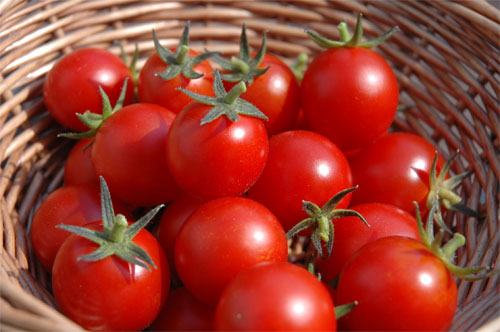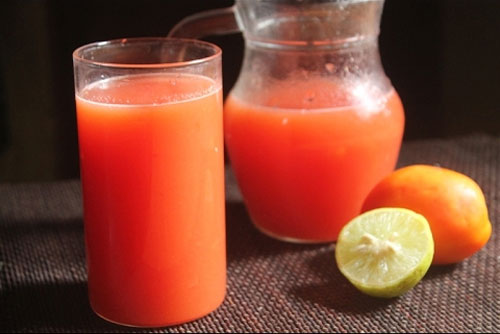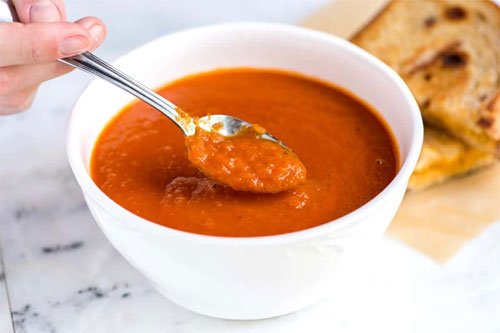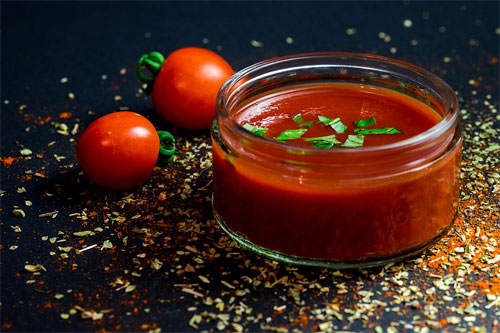5 Reasons Why You Need 100 Pounds Of Tomatoes
By Daisy Luther
Here’s my recommendation for your end-of-summer food preservation. First, you need 100 pounds of tomatoes (45 kilograms).

Yes – 100 pounds, and more if you can get them. No other item of produce increases in nutrients when cooked and stored like tomatoes. Canning them is like loading your shelves with vitamins. These vitamins have the delicious bonus of providing tasty meals throughout the winter when fresh fruits and veggies are expensive (and scarce for many of us if you prefer to consume foods grown close to home.)
I got most of my tomatoes from local friends who had an over-abundance, so I didn’t pay a lot for them. You can often find tomatoes by the bushel at your local farmer’s market.
So here are the five reasons, as well as instructions and recipes for prepping and canning these vitamin-laden goodies:
– Simple sauce with tomatoes, onions, and garlic;
– Tomato broth;
– Italian marinara;
– Salsa;
– Ketchup.
If you purchased all of these items organic, over the course of the year it would cost at least triple the price of spending a few days making them yourself.
Prepping tomatoes for canning
The first step for all of these recipes is to wash and peel your tomatoes.
I always soak my fruits and veggies in a baking soda wash, whether they are organic or not. Add one cup of baking soda to tepid water, soak, then rinse well.
Next, you have to peel your tomatoes. The easiest way to peel tomatoes is to take them from boiling water to an ice bath and then squeeze them, as follows.
First, put water on to boil in a large non-reactive stockpot. You don’t need to wash or cut the tomatoes before blanching them. In batches, place the tomatoes into the boiling water for about 3 minutes. (This time is not engraved in stone – don’t panic if you go over the time by a little bit.)
You can test them by gently using your tongs to see if the skins have loosened. After you scoop the tomatoes out of the boiling water, place them directly into an ice bath and leave them there for at least 3 minutes. I like to use long tongs for this because you transfer less of the hot water into your ice bath.
Once the tomatoes are cool enough to easily handle, use your fingers to dig the stem end out of the tomato and discard it. Then, squeeze the tomato over your blender – the skin should slide right off and leave you with a blender full of pulp. You don’t need to remove the seeds.
Now you’re ready to can tomatoes.
1. Simple Tomato Sauce

This thin puree is as simple as running your tomatoes through the blender and possibly adding some garlic, onions, and salt to them. It can be used as a base for soup, chili, spaghetti sauce, enchilada sauce, or any other purpose that requires crushed tomatoes. I like to can this because it’s pretty neutral and can be used in so many different recipes throughout the year.
I didn’t give measurements, because this simple sauce can be made from any amount of tomatoes that you happen to lay hands upon. It is also a great way to use up soft or overripe tomatoes quickly.
Ingredients:
• Peeled tomatoes (any variety);
• 1/2 small onion per jar;
• 1 clove of garlic per jar;
• Sea salt or canning salt to taste;
• Lemon juice.
Directions:
1. Peel tomatoes and place them directly into the bowl of your food processor or pitcher of your blender. Approximately 3 cups of unprocessed tomato will fill a quart jar. If you’re using onions and garlic, add those to the food processor at the same time. Use the pulse option on your processor until the mixture reaches your desired consistency.
2. Pour this into a sanitized quart jar.
3. Repeat until you have a canner load of sauce.
4. Add a dash of salt to each jar. If you are water bath canning, add 2 tbsp of lemon juice to each jar. If you are pressure canning, the lemon juice is not necessary.
5. In a water bath canner, process your sauce for 40 minutes at sea level, adjusting for altitude. Alternatively, you can process the sauce in your pressure canner for 25 minutes at 10 pounds of pressure, adjusting for altitude.
The Whole Theory of Tomatoes
I’ve been experimenting with ways to get more mileage from my food. I began straining my fruit purees before making jam and had great results, so instead of cooking my tomatoes down for hours and letting all of that goodness just evaporate, I decided to use the same method with some of my tomato products.
When processing my tomatoes for marinara, salsa, and ketchup, I decided to see if I could cut down the cooking time and preserve the extra liquid for a vegetable broth base for soup or cooking rice.
After I pureed my veggies, as per the directions in all of the recipes, I poured the puree into a colander that was resting over a large stockpot.
I left it to drain for anywhere from 2 hours to overnight. The longer it drains, of course, the less liquid will remain in the sauce. The liquid that drains off can then be processed as a tomato broth for soup.
This is what you’ll be left with – thick tomato-ey goodness that doesn’t require a half-day of cooking to reach the proper consistency! What you do from here is based on what you plan to make. For salsa, I use the tomatoes as they are. For marinara sauce or ketchup, I run it through the blender again to get a nice smooth puree.
That’s not the only way you can extend your tomatoes. Did you know that you can make a thick sauce from the peels? As with most fruit, this is the part that contains the most pectin.
When peeling your tomatoes, simply peel them over a small pot in order to catch any extra juice. When you’re done, simmer the peels in the juice for a few hours. At this point, you have two options.
1. Allow the mixture to cool. Strain it over a mesh colander into a pot, then squeeze out the peels to get the thick tomato paste from them.
2. Use a mill to separate the paste from the peels. (This is the most effective method and will net you the most sauce.)
2. Tomato Broth

Strain your liquid as described above.
Pour this into a sanitized quart jar.
Add a dash of salt to each jar. If you are water bath canning, add 2 tbsp of lemon juice to each jar. If you are pressure canning, the lemon juice is not necessary.
In a water bath canner, process your sauce for 40 minutes at sea level, adjusting for altitude. Alternatively, you can process the broth in your pressure canner for 20 minutes at 10 pounds of pressure, adjusting for altitude.
The liquid will separate, and you will have tomato “sediment” at the bottom. This is perfectly normal. This broth can be used as a base for soup, in place of liquid for cooking meat in the crockpot, or for cooking rice.
Now, with your drained tomatoes, you can make the following products.
3. Marinara
If you have already drained your tomatoes, gauge your recipe to approximately 3 cups of rough puree per quart jar.
For a 7 quart batch, you will need 2 bell peppers, any color, 2 onions, and 1-2 heads of garlic.
In batches, puree your tomatoes and veggies until smooth, then add them to a large stockpot.
Add the following seasonings – the first amount is per pound of tomatoes, and the second amount is for a 7 quart batch of sauce.
• 1 tbsp – coconut sugar – 1/3 cup;
• 1 tsp – sea salt – 2 and 1/2 tbsp;
• 1 tsp – thyme – 2 and 1/2 tbsp;
• 1 tbsp – oregano – 1/3 cup;
• 1 tbsp – basil – 1/3 cup;
• 1 pinch – powdered clove (trust me!) – 1 tbsp;
• black pepper to taste;
• 1 pinch – smoked Hungarian paprika if you can find it – 1 tbsp;
• 2 tbsp – extra virgin olive oil – 2/3 cup.
With the lid off, bring the sauce to a simmer for about an hour, stirring occasionally. This will allow all of the seasonings to meld into the sauce.
If at serving time your sauce is still runnier than you prefer, simply stir in a small tin of tomato paste to thicken it.
1. Fill sanitized quart jars with sauce, allowing 1 inch of headspace.
2. Wipe the lip of your jars with a cloth dipped in white vinegar and then place the lids on.
3. Process the sauce in your pressure canner for 25 minutes at 7 pounds of pressure, adjusting for altitude.
4. Allow the jars to cool undisturbed for at least 12 hours or until cooled. Test the seals before putting them away.
4. Salsa
Ingredients:
• 14 cups of drained tomatoes;
• 4 bell peppers, seeded;
• 1/2 cup of jalapeno peppers, with center removed (leave in seeds for super-spicy salsa, reduce or even eliminate the amount of jalapenos for a milder salsa);
• 2 medium onions;
• 1/2 cup of lemon or lime juice;
• 4 cloves of garlic;
• 1/4 to 1/2 cup of fresh cilantro leaves (if you do not like cilantro, use parsley instead);
• 1 tbsp of coconut sugar;
• 1 tsp of chili powder;
• 1/2 tsp of cumin powder.
Directions:
1. Dump your drained tomatoes into a large mixing bowl.
2. Using your food processor, add the tomatoes, peppers, onion, garlic, and cilantro. Process on the “chop” function until you’ve reached the desired chunkiness, then pour each batch into the mixing bowl with the tomatoes.
3. Once all of your veggies are in the bowl, stir in your lemon or lime juice and all of your seasonings until they are well combined.
4. Ladle the salsa into the prepared jars that are eagerly awaiting it.
5. Wipe the lip of the jars, place the flats and rings on them, and lift them into the vigorously boiling water bath.
6. In a water bath canner, process your salsa for 25 minutes at sea level, adjusting for altitude. Alternatively, you can process the sauce in your pressure canner for 15 minutes at 10 pounds of pressure, adjusting for altitude.
5. Ketchup

Once you try this taste-of-summer condiment, those little packets and squirt bottles will never satisfy your ketchup craving again. Plus, it’s real tomato-y goodness without all of the additives.
Ingredients:
• 12 cups of drained tomatoes;
• 2 onions, quartered;
• 2 sweet peppers;
• 1-1/2 cups of cider vinegar;
• 1/2 cup of coconut sugar;
• 1 tbsp of salt;
• 1 tsp of celery seed;
• 1/2 tsp ground allspice;
• 1 tsp ground cloves;
• 1/4 tsp ground cinnamon.
Directions:
1. Using your blender, puree your drained tomatoes with the peppers and onions – you will have to do numerous batches. Pour each pureed batch into a large stockpot.
2. Bring the mixture to a boil, then reduce heat and simmer it for one hour, uncovered.
3. Stir in the vinegar and spices and continue to simmer with the lid off. It will take 1-2 hours to reach a desirable consistency.
4. Once the ketchup is at your preferred consistency, ladle it into pint jars.
5. Lid the jars and process them in a water bath canner for 15 minutes, adjusting for altitude.
See? 100 pounds of tomatoes isn’t actually unrealistic at all. If you are lucky enough to have even more of a tomato harvest, simply rinse and repeat the above recipes. My goal is to stockpile enough tomato products that there’s no need to purchase the nasty, high-fructose corn syrup, BPA-tainted storebought items all winter.
If you happen to have extra tomatoes, dry them. You can store these in olive oil for delicious gourmet additions to pizzas and salads. Here is a recipe for that:
Dry tomatoes in the oven
Ingredients:
• 5 pounds fresh tomatoes;
• 1 tablespoon table salt;
• 1/2 teaspoon ground black pepper;
• 1 teaspoon garlic salt;
• 1/4 cup olive oil;
• More olive oil for packing into a jar, if desired;
• Fresh herbs for seasoning, if desired.
Directions:
• Line a baking sheet with baking parchment.
• Set the oven for 200°F (95°C).
•Place halved tomatoes on a baking sheet, on an oven tray.
• Blend salt, pepper, and garlic salt in a small bowl.
•Sprinkle tomatoes with the dry seasonings, generously.
•Drizzle olive oil over the tomatoes.
• Roast until the tomatoes are leathery and shriveled, with crisp edges. Tiny cherry tomatoes need about 3 hours. The bigger tomatoes need 4, 6 or even 8 hours’ drying. You can confidently let big Roma tomatoes dry overnight (8 hours) – if you get up early.
• Cool thoroughly and pack in olive oil to cover in a very clean, very dry jar.
• Add an optional sprig of rosemary, thyme or oregano, or basil leaves. If you love heat, add a small chili pepper to the jar.
• Store in the refrigerator.
The dry tomatoes will keep up to six months.
yogaesoteric
September 9, 2020
